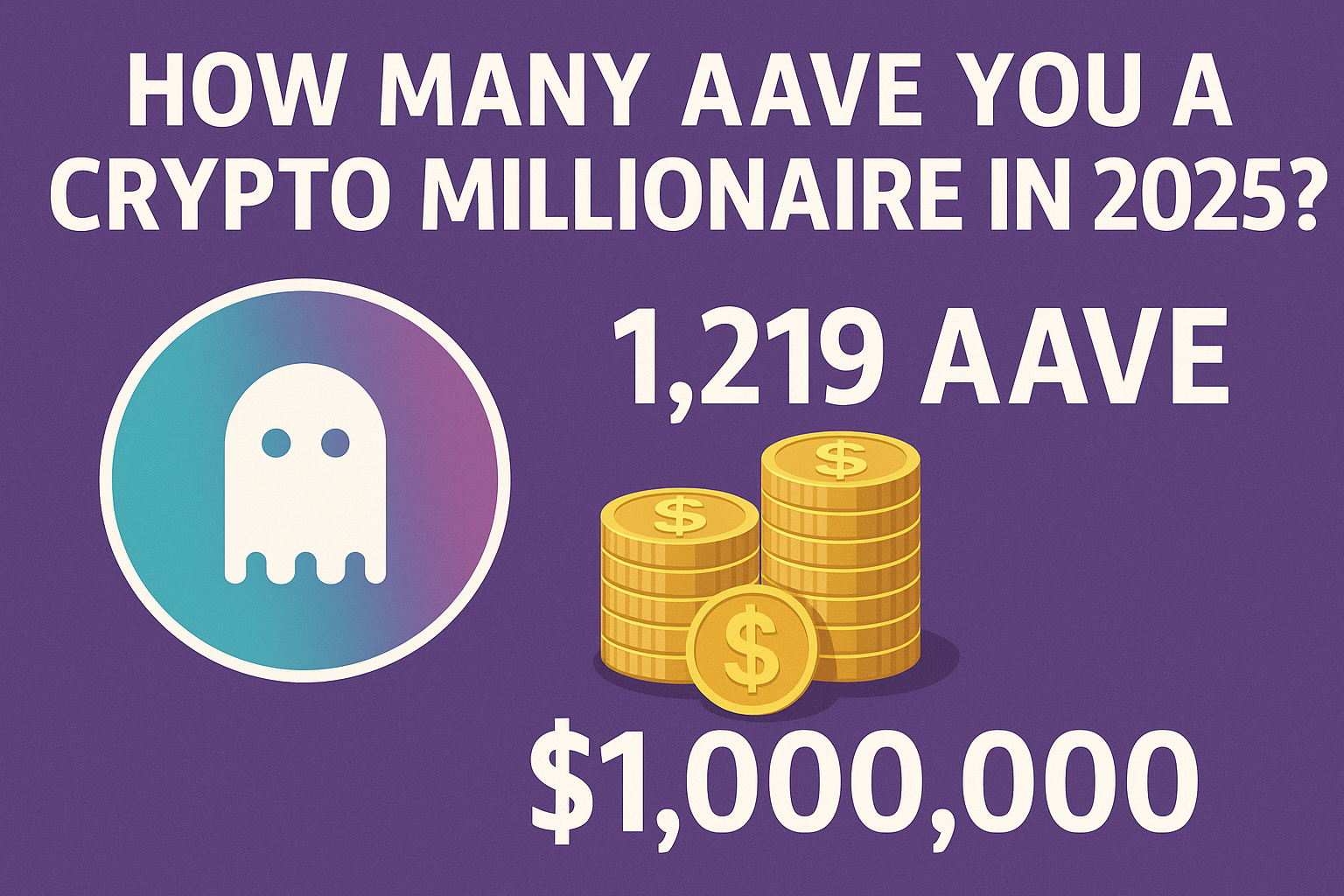How Many AAVE Make You a Crypto Millionaire in 2025?
Find out exactly how many AAVE you need to reach $1,000,000, with live price math, tokenomics, risks, and strategy—explained simply but deeply for real investors.

How many AAVE do I need to become a crypto millionaire?” sounds like a single line of math. Divide one million dollars by the AAVE price, buy that many tokens, and wait. But the moment you run the calculation, you realize there’s a bigger story. The number of AAVE you need changes every minute with the market, and it depends on your time horizon, your conviction in the Aave Protocol, its token design, and how you manage risk in a volatile DeFi landscape. The right answer blends live numbers with the fundamentals that can sustain those numbers.
At the time of writing, AAVE is trading near the price shown above (updated live). Using the basic formula—Required tokens = $1,000,000 ÷ AAVE price—you can estimate the holdings you’d need today. If AAVE were $300, you’d need about 3,334 tokens for a $1,000,000 portfolio. If AAVE doubled, you’d need half as many; if it halved, you’d need twice as many. The math is easy; the hard part is deciding what makes AAVE worth $300, $600, or beyond. That’s where understanding the protocol, tokenomics, and risks becomes essential. The Aave docs outline that AAVE is a governance and staking asset that helps secure the protocol and align incentives for depositors and borrowers in a non-custodial liquidity market.
What AAVE Actually Is—and Why That Matters
Aave is one of crypto’s most established DeFi lending protocols. Users supply assets to earn yield and can borrow over-collateralized loans, with positions represented by interest-bearing aTokens in V2 and newer mechanisms in V3. The AAVE token underpins governance and can be staked in the Safety Module to backstop shortfall events, meaning token holders share both the upside of protocol growth and part of its security responsibilities. This structure is spelled out in Aave’s own documentation and Safety Module specs, which describe staking, cooldowns, and potential slashing during shortfall events.
This utility matters for price because tokens that capture governance value, potential fee flows, or buyback dynamics can attract different investor profiles than pure meme assets. Moreover, the live and historical data on circulating supply and capped max supply provide a boundary for valuation narratives. Several reputable trackers show AAVE with a circulating supply of around 15.23 million and a maximum supply of 16 million, which constrains long-term dilution compared with uncapped models.
The Core Math: How Many AAVE Make $1,000,000?
The baseline equation is straightforward:
AAVE needed = $1,000,000 ÷ current AAVE price
Plugging in the live figure from the price card above provides your exact, moment-to-moment number. For clarity, consider a few anchor points to internalize the relationship:
-
At $250 per AAVE, you’d need about 4,000 AAVE for $1,000,000.
-
At $300 per AAVE, you’d need about 3,334 AAVE for $1,000,000.
-
At $500 per AAVE, you’d need about 2,000 AAVE for $1,000,000.
-
At the prior cycle high near $665, you’d have needed roughly 1,504 AAVE. Historical sources place AAVE’s all-time high in May 2021 around that level, giving useful context for upside scenarios.
These aren’t predictions; they’re reference points to help you decide whether your plan depends on accumulating more AAVE at today’s levels or banking on appreciation.
Why Circulating and Max Supply Matter

When you ask how many AAVE are needed to become a crypto millionaire, the circulating and max supply determine how scarce each token is and how valuation might scale. With roughly 15.23 million AAVE circulating and a max supply of 16 million, the asset sits on the “scarcer” end compared with many governance tokens. Scarcity alone doesn’t guarantee price appreciation, but it sets a ceiling on dilution risk if token unlocks and emissions are predictable. Leading data sources consistently report these supply figures, which investors use in basic metrics like market capitalization and fully diluted valuation (FDV).
Tokenomics in Motion: Safety Module, “Umbrella,” and Value Capture
Beyond static supply, tokenomics evolve. Aave’s Safety Module lets AAVE holders stake to help secure the protocol, earning rewards but accepting slashing risk in extreme shortfalls. This relationship between AAVE and protocol safety is codified in Aave’s documentation and public repositories.
In the last cycle, community and research posts discussed proposals branded as “Aavenomics,” along with ideas for buybacks, profit distribution, and an updated safety mechanism sometimes referenced as “Umbrella.” Third-party research summaries have covered these drafts and the direction of travel—aiming to improve token value capture and protection against tail risks. While details continue to evolve through governance, the broad takeaway for investors is that AAVE’s role may deepen as the protocol iterates on how revenue, risk, and incentives flow through the token. Keep an eye on official governance and documentation updates alongside reputable research to avoid relying on outdated assumptions.
What History Suggests—And What It Doesn’t
Historical highs and lows help you frame outcomes, but can’t guarantee repeats. Trackers show AAVE’s prior all-time high around $660–$666 in May 2021, with sharp drawdowns in subsequent bear phases. In 2025, AAVE trades at a fraction of that peak but above prior cycle lows, reflecting both the resilience and cyclicality of DeFi assets. Using reliable aggregators for price, market cap, and supply helps ground your planning in verifiable numbers rather than headlines.
Building Your Million: Accumulation and Scenario Planning
If your goal is one million dollars denominated in fiat, you can reach it either by owning enough AAVE at today’s prices or by owning fewer tokens and letting appreciation do some of the work. The right mix depends on your risk tolerance and time frame.
First, quantify your “base case.” Suppose you aim to hold 2,500 AAVE. At $300, that’s $750,000—not a million—so your plan implicitly assumes appreciation to about $400 per AAVE. If you instead target 3,500 AAVE at $300, you’re at $1.05 million pre-tax, which means you need to buy more tokens up front but depend less on future price expansion. There’s no free lunch: buying more AAVE concentrates risks; buying fewer AAVE amplifies your reliance on price appreciation.
Second, layer realistic constraints. Your acquisition pace might be monthly, not instant. A DCA approach translates the million-dollar dream into a schedule that smooths entry price and reduces timing risk. But because AAVE is volatile, a DCA plan should be flexible enough to pause during abnormal spikes or add during unusually attractive drawdowns.
Third, remember that a round-number target is a snapshot. Being a crypto millionaire is not a permanent state if your portfolio swings ±30% in a week. Decide whether your real goal is a sustained average value above $1,000,000, a realized cash amount after taxes and fees, or an on-chain portfolio value that can be rehypothecated or staked.
Staking and Yield: Helpful Boost or Hidden Risk?

Staking AAVE in the Safety Module can produce extra yield, potentially closing a gap between your portfolio and $1,000,000. However, unlike pure yield farming, this yield exists precisely because stakers take on protocol risk. Safety Module documentation explains cooldowns, withdrawals, and how slashing might work during a shortfall. Governance-driven changes and newer security architectures like “Umbrella” have also been discussed, which means that yields and rules can change. Treat staking return assumptions as variable, and verify current terms in official Aave resources before basing your millionaire math on them.
Taxes, Fees, and the “After-Costs” Reality
Your million is not truly a million until you account for friction. Exchange fees, on-chain gas, and—most significantly—taxes can reduce the headline figure. If you plan to unwind a large AAVE position, think through liquidity, slippage, and the tax basis of each lot if you used DCA. Many investors find it useful to target a pre-cost value above $1,000,000 so that, net of fees and taxes, the goal still holds.
Risk Management: The Uncomfortable Non-Negotiable
Even if you believe in How Many AAVE Make and DeFi, concentration risk and smart-contract risk remain. Aave has weathered multiple market cycles and is widely integrated, but risk never falls to zero in open finance. The Safety Module exists because tail events cannot be eliminated. The best time to plan exits, hedges, and position sizing rules is before volatility arrives. Decide what percent drawdown would force you to reduce exposure and what percent gain triggers partial profit-taking to “hard-lock” progress toward your millionaire target.
Putting It Together: A Practical Millionaire Blueprint
If you want a single action plan, make it this:
Start by pulling today’s AAVE price and computing the exact token count for $1,000,000 with the formula above. If that number is beyond your budget, pick a token target you can realistically accumulate, then solve for the price required for it to equal $1,000,000. If your budget allows, consider holding a slightly higher AAVE count than the bare minimum so that staking returns or modest appreciation put you comfortably over seven figures after costs. Keep monitoring official Aave communications for governance and tokenomics updates—especially changes to staking, buybacks, or fee distribution—because those can influence long-term value capture. Use reputable market data sources for circulating supply, FDV, and price history so you’re modeling with consistent inputs rather than speculation.
Worked Example with Today’s Ballpark Price
For a concrete feel, assume AAVE trades around $297–$300 at the moment you’re reading this. At $297, you’d need roughly 3,367 AAVE to hit $1,000,000. At $300, you’d need about 3,334 AAVE. If you can only afford 2,000 AAVE, you’d need the price to reach $500 per token to be a crypto millionaire—a level consistent with a recovery but below the prior cycle high. Seen another way, if you can accumulate 1,500 AAVE, you’d need a price very close to the historical peak to cross a million in portfolio value. These framing exercises don’t predict the future—they show how sensitive your goal is to both price and token count. For live pricing and historical extremes, verify with widely used market trackers before acting.
Conclusion
The precise number of AAVE you need for $1,000,000 is a moving target you can compute in seconds: divide your goal by the live AAVE price. The real work is building conviction in the Aave Protocol, understanding how tokenomics like the Safety Module and potential value-capture changes may influence long-term pricing, and managing risk so a volatile drawdown doesn’t erase months or years of progress.
With circulating and max supply relatively tight and a mature DeFi footprint, AAVE offers a credible foundation for a high-conviction plan—but only if you back the math with discipline, research, and a strategy for fees, taxes, and market shocks. Start with today’s number, map your accumulation, and keep sharpening your assumptions as the protocol and the market evolve.
FAQs
Q: How do I calculate exactly how many AAVE I need right now?
Use the formula AAVE needed = $1,000,000 ÷ live AAVE price and plug in the current figure from a reliable source. The live price card above updates automatically so you can recompute on the spot.
Q: Does AAVE have a capped supply?
Multiple reputable trackers list a circulating supply near 15.23 million and a maximum supply of 16 million AAVE, which constrains long-term dilution compared to uncapped tokens. Always verify the latest figures before modeling.
Q: What makes AAVE valuable beyond speculation?
The token governs the Aave Protocol and can be staked to help secure it via the Safety Module. Governance, staking rewards, and potential value-capture changes can all influence demand for AAVE over time.
Q: Is staking AAVE risk-free?
No. Safety Module staking includes mechanisms like cooldowns and potential slashing during shortfall events, as described in Aave’s technical materials. Treat staking yield as compensation for risk, not a free bonus.
Q: Could tokenomics updates change my millionaire math?
Potentially. Community discussions of “Aavenomics,” buybacks, and security architecture updates such as “Umbrella” indicate tokenomics can evolve through governance. Monitor official channels and credible research for changes that affect value capture and staking terms.
Also Read: Best Crypto Tax Software Australia Top 10 Tools 2025 Review









